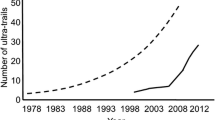Abstract
It has been suggested that stronger coupling between locomotory and breathing rhythms may occur as a result of training in the particular movement pattern and also may reduce the perceived workload or metabolic cost of the movement. Research findings on human locomotor–respiratory coordination are equivocal, due in part to the fact that assessment techniques range in sensitivity to important aspects of coordination (e.g. temporal ordering of patterns, half-integer couplings and changes in frequency and phase coupling). An additional aspect that has not received much attention is the adaptability of this coordination to changes in task constraints. The current study investigated the effect of running training on the locomotor-respiratory coordination and the adaptive strategies observed across a wide range of walking and running speeds. Locomotor-respiratory coordination was evaluated by the strength and variability of both frequency and phase coupling patterns that subjects displayed within and across the speed conditions. Male subjects (five runners, five non-runners) locomoted at seven different treadmill speeds. Group results indicated no differences between runners and non-runners with respect to breathing parameters, stride parameters, as well as the strength and variability of the coupling at each speed. Individual results, however, showed that grouping subjects masks large individual differences and strategies across speeds. Coupling strategies indicated that runners show more stable dominant couplings across locomotory speeds than non-runners do. These findings suggest that running training does not change the strength of locomotor–respiratory coupling but rather how these systems adapt to changing speeds.









Similar content being viewed by others
References
Alexander RM (1993) Breathing while trotting. Science 262:196–197
Baudinette RV, Gannon BJ, Runciman WB, Wells S, Love JB (1987) Do cardiorespiratory frequencies show entrainment with hopping in the tammar wallaby? J Exp Biol 129:251–263
Bechbache RR, Duffin J (1977) The entrainment of breathing frequency by exercise rhythm. J Physiol (Lond) 272:553–561
Bernasconi P, Kohl J (1993) Analysis of co-ordination between breathing and exercise rhythms in man. J Physiol (Lond) 471:693–706
Bernasconi P, Burki P, Koller EA, Kohl J (1995) Running training and co-ordination between breathing and running rhythms during aerobic and anaerobic conditions in humans. Eur J Appl Physiol 70:387–393
Bonsignore MR, Morici G, Abate P, Romano S, Bonsignore G (1998) Ventilation and entrainment of breathing during cycling and running in triathletes. Med Sci Sports Exerc 30:239–245
Bramble DM, Carrier DR (1983) Running and breathing in mammals. Science 219:251–256
Ebert D, Raßler B, Hefter H (2000) Coordination between breathing and forearm movements during sinusoidal tracking. Eur J Appl Physiol 81:288–296
Garlando F, Kohl J, Koller EA, Pietsch P (1985) Effect of coupling the breathing- and cycling rhythms on oxygen uptake during bicycle ergometry. Eur J Appl Physiol 54:497–501
Glass L (2001) Synchronization and rhythmic processes in physiology. Nature 410:277–284
Hill AR, Adams JR, Parker BE, Rochester DF (1988) Short-term entrainment of ventilation to the walking cycle in humans. J Appl Physiol 65:570–578
Jasinkas CL, Wilson BA, Hoare J (1980) Entrainment of breathing rate to movement frequency during work at two intensities. Respir Physiol 42:199–209
Kelso JAS (1995) Dynamic Patterns. The self-organization of brain and behavior. MIT, Cambridge, Mass.
Kelso JAS, Jeka JJ (1992) Symmetry breaking dynamics of human multilimb coordination. J Exp Psychol Hum Percept Perform 18:645–668
Kohl J, Koller E, Jager M (1981) Relation between pedaling and breathing rhythm. Eur J Appl Physiol 47:223–237
Mackey MC, Milton JG (1987) Dynamical diseases. Ann N Y AcadSci, 504:16–32
Owerkowicz T, Farmer CG, Hicks JW, Brainerd EL (1999) Contribution of gular pumping to lung ventilation in monitor lizards. Science 284:1661–1663
Paterson DJ, Graeme AW, Morton AR, Henstridge JD (1986) The entrainment of ventilation frequency to exercise rhythm. Eur J Appl Physiol 55:530–537
Pompe B, Blidh P, Hoyer D, Eiselt M (1998) Using mutual information to measure coupling in the cardiorespiratory system. IEEE Eng Med Biol Mag 17:32–39
Press WH, Flannery BP, Teukolsky SA, Vetterling WT (1990) Numerical Recipes in Pascal. Cambridge University Press, New York
Raßler B, Kohl J (1996) Analysis of coordination between breathing and walking rhythms in humans. Respir Physiol 106:317–327
Schmidt RC, Carello C, Turvey MT (1990) Phase transitions and critical fluctuations in the visual coordination of rhythmic movements between people. J Exp Psychol Hum Percept Perform 16:227–247
Schöner G, Kelso JAS (1988) Dynamic pattern generation in behavioral and neural systems. Science 239:1513–1520
Takano N (1995) Phase relation and breathing pattern during locomotor/respiratory coupling in uphill and downhill running. Jpn J Physiol 45:47–58
Turvey MT, Rosenblum LD, Schmidt RC, Kugler PN (1986) Fluctuations and phase symmetry in coordinated rhythmic movements. J Exp Psychol Hum Percept Perform 12:564–583
Van Alphen J, Duffin J (1994) Entrained breathing and oxygen consumption during treadmill walking. Can J Appl Physiol 19:432–440
Viala D (1986) Evidence for direct reciprocal interactions between the central rhythm generators for spinal 'respiratory' and locomotor activities in the rabbit. Exp Brain Res 63:225–232
Viala D, Freton E (1983) Evidence for respiratory and locomotor pattern generators in the rabbit cervico-thoracic cord and their interactions. Exp Brain Res 49:247–256
Viala D, Vidal C (1978) Evidence for distinct spinal locomotion generators supplying respectively fore- and hindlimbs in the rabbit. Brain Res 155:182–186
Young IS, Alexander AJ, Woakes AJ, Buller PJ, Anderson L (1992) The synchronization of ventilation and locomotion in horses (Equus caballus). J Exp Biol 166:19–31
Acknowledgements
We thank the reviewers for their time and insightful comments. We also acknowledge Dr. Patty Freedson for her input to this study. This work was funded in part by a grant from the Whitaker Foundation (RG-99-0097), awarded to Richard Van Emmerik.
Author information
Authors and Affiliations
Corresponding author
Rights and permissions
About this article
Cite this article
McDermott, W.J., Van Emmerik, R.E.A. & Hamill, J. Running training and adaptive strategies of locomotor-respiratory coordination. Eur J Appl Physiol 89, 435–444 (2003). https://doi.org/10.1007/s00421-003-0831-5
Accepted:
Published:
Issue Date:
DOI: https://doi.org/10.1007/s00421-003-0831-5




